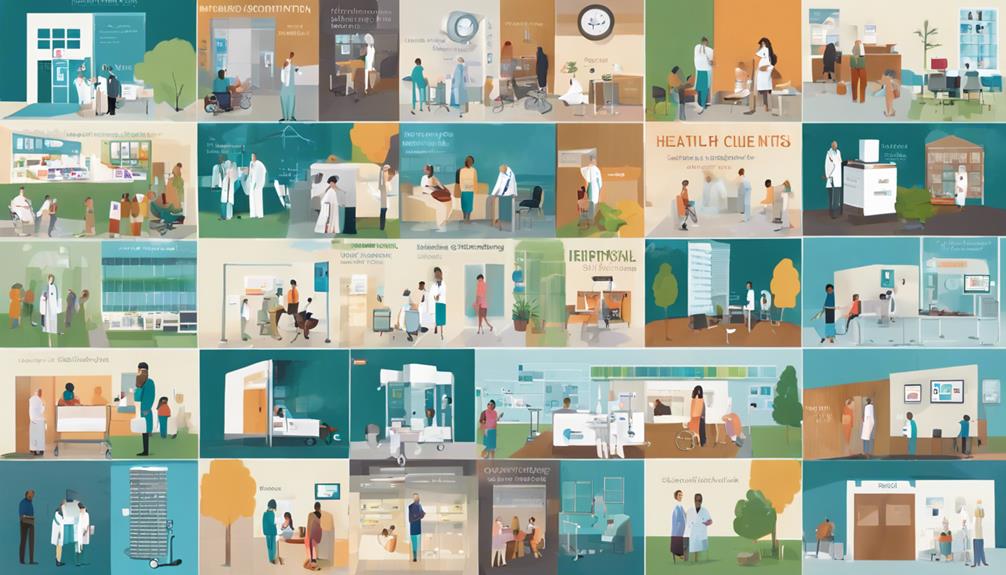You'll find that approximately 6,000 health systems operate in the United States. These systems vary greatly, with both public and private organizations delivering medical services. The distribution is influenced by geography, with denser urban areas having more providers than rural locations. In urban settings, access to timely care is usually better, while rural areas often face shortages. Additionally, market dynamics and regulatory factors can impact how these systems function and serve their communities. Understanding these factors highlights the complexity in the healthcare landscape, which you can explore further for more detailed insights.
Overview of Health Systems

In the U.S., health systems encompass a diverse array of organizations and facilities that work together to deliver medical services and manage patient care efficiently.When Health Anxiety Takes Over
Over time, the health system evolution has been shaped by various factors, including technological advancements, demographic shifts, and changing patient needs. You'll notice that healthcare policy plays an essential role in this evolution, influencing how services are delivered and funded.
Policies like the Affordable Care Act have made significant impacts, fostering greater access to care and encouraging the development of integrated health systems. These integrated systems aim to improve care coordination and patient outcomes by linking hospitals, outpatient facilities, and community services.
Additionally, the shift from volume-based to value-based care reflects a growing emphasis on patient-centered approaches. This transformation not only aligns incentives for providers but also drives innovation in service delivery.
Types of Health Systems
When you consider health systems in the US, you'll find two primary types: public and private.
Public health systems are typically funded by government sources and aim to provide accessible care for all citizens.
In contrast, private health systems rely on individual payments and insurance plans.
Understanding these differences is essential for grasping how healthcare is delivered and financed in your community.
Public Health Systems
Public health systems play a crucial role in promoting community health and preventing disease through organized efforts and informed choices. These systems are designed to implement public health initiatives that address various health challenges faced by communities. By focusing on education, accessibility, and preventive measures, you'll find that these initiatives greatly enhance the overall health of populations.
Community health programs, a critical component of public health systems, directly engage local populations to foster healthy behaviors. These programs often target specific issues such as obesity, smoking cessation, and mental health, utilizing data-driven strategies to maximize effectiveness. For instance, evidence shows that programs promoting physical activity and nutrition can lead to significant reductions in chronic diseases.
Moreover, public health systems advocate for policy changes that create environments conducive to health. By collaborating with community organizations, they guarantee that resources are allocated effectively, reaching those who need them most.
Essentially, public health systems serve as a backbone for community health, guiding initiatives that not only mitigate immediate health concerns but also lay the groundwork for a healthier future. Understanding their impact can empower you to participate in or support such initiatives actively.
Private Health Systems
Private health systems encompass a variety of models that deliver healthcare services, often focusing on efficiency, innovation, and patient choice. These systems typically rely on a network of private insurance providers, which can greatly influence the quality and accessibility of care you receive. By opting into specific insurance networks, you often gain access to a range of healthcare providers and facilities that can cater to your individual needs.
Patient demographics play an essential role in shaping the structure of private health systems. For instance, areas with higher-income populations may see a greater concentration of specialized services and advanced technologies, while those with lower demographics may have limited access, thereby impacting overall health outcomes. Additionally, these systems tend to prioritize preventive care and wellness programs to maintain a healthy patient base and reduce costs in the long run.
Ultimately, understanding the dynamics of private health systems helps you make informed decisions about your healthcare options. By recognizing how insurance networks and patient demographics interact, you can navigate the complexities of private healthcare more effectively, ensuring you receive the care that best meets your needs.
Health System Statistics

Approximately 6,000 health systems operate across the United States, reflecting a diverse landscape of care delivery models and organizational structures. These systems vary greatly in size, scope, and the services they provide. By analyzing health data, you can see that larger systems often have more resources and capabilities to serve complex patient demographics. For instance, they may offer specialized services that smaller systems can't afford, impacting accessibility and quality of care.
In understanding these statistics, it's crucial to reflect on not just the number of health systems but also their distribution across urban and rural areas. Urban systems typically cater to higher patient volumes and a more diverse population, while rural systems often face challenges like limited funding and workforce shortages.
Moreover, the integration of health data technologies has become vital in addressing the varying needs of patient demographics. Systems that effectively leverage health data can enhance patient outcomes through tailored interventions and improved resource allocation.
As healthcare continues to evolve, understanding these statistics will help you assess the effectiveness and efficiency of different health systems throughout the country.
Regional Variations
Regional variations in health systems across the U.S. greatly influence access to care, with factors like geography, population density, and local healthcare policies shaping the delivery of services.
These regional disparities often result in significant differences in healthcare accessibility. For instance, urban areas typically have a higher concentration of healthcare providers and facilities, making it easier for residents to obtain timely care. Conversely, rural regions may face shortages of healthcare professionals and services, leading to increased travel times and barriers to access.
Moreover, state-specific healthcare policies can either mitigate or exacerbate these disparities. States that invest in community health initiatives often see improved healthcare outcomes, while those with restrictive policies may hinder access to essential services.
It's also vital to recognize how socioeconomic factors, such as income and education levels, interact with these regional differences. Individuals in lower-income areas might struggle more than others to access necessary care, regardless of their proximity to healthcare facilities.
Impact on Patient Care

When you consider the impact of health systems on patient care, access to services is a critical factor that shapes outcomes.
Quality of care and effective care coordination efforts also play significant roles in ensuring patients receive timely and appropriate treatments.
Together, these elements can greatly influence your overall health experience within the system.
Access to Services
Access to services greatly influences patient care outcomes, as timely medical intervention can prevent complications and improve overall health. For you, having seamless access to healthcare services is imperative, especially in rural areas where healthcare resources can be scarce.
Telehealth access has emerged as an important tool in bridging the gap between patients and providers, allowing you to consult with healthcare professionals without the need for long travel distances.
Studies show that telehealth can considerably enhance access to care, reduce wait times, and improve patient satisfaction. In rural healthcare settings, where specialists may not be readily available, telehealth can facilitate quicker diagnoses and treatment plans, ultimately leading to better health outcomes.
Moreover, increased telehealth access can alleviate the burden on local healthcare systems, enabling them to focus on acute cases while managing routine follow-ups remotely.
However, it's critical to guarantee that technological barriers, such as internet connectivity, don't impede your access to these services. By addressing these challenges, healthcare systems can create a more equitable environment where you receive timely and effective care, no matter where you live.
Quality of Care
The quality of care you receive directly impacts your health outcomes, with factors such as provider expertise, treatment protocols, and patient engagement playing pivotal roles in the effectiveness of healthcare services.
High-quality care is often measured through various quality metrics, which assess the performance of healthcare systems and providers. These metrics include rates of complications, readmissions, and patient satisfaction scores, all of which contribute to understanding patient outcomes.
When you engage with healthcare services, the quality of care you receive can determine not only your immediate recovery but also your long-term health trajectory. For instance, effective treatment protocols and skilled providers can considerably reduce the risk of adverse outcomes. Conversely, low-quality care can lead to increased complications and poorer patient experiences.
Research shows that patients treated in high-performing health systems often report better health outcomes and higher satisfaction levels.
Therefore, understanding and prioritizing quality metrics can empower you to make informed decisions about your healthcare. By actively seeking out high-quality care options, you can improve your overall health and well-being, ensuring that you receive the best possible treatment during your healthcare journey.
Care Coordination Efforts
Effective care coordination efforts greatly enhance your patient experience by guaranteeing that all members of your healthcare team communicate seamlessly and work towards unified treatment goals.
When you receive care integration, your various healthcare providers share crucial information, reducing the chances of errors and duplications. This collaborative approach not only streamlines your treatment but also fosters a more holistic view of your health status.
Patient navigation plays a critical role in this process. Navigators help you understand your care options, schedule appointments, and follow through on treatment plans. This guidance alleviates confusion and empowers you to take charge of your health journey.
Research indicates that effective patient navigation can lead to improved health outcomes, as it guarantees that you remain engaged and informed throughout your care.
Moreover, coordinated care greatly shortens wait times for services and enhances access to specialists. By prioritizing communication and collaboration, healthcare teams can address your needs more efficiently, ultimately leading to higher satisfaction rates.
To conclude, strong care coordination efforts are essential for delivering high-quality care and guaranteeing your needs are met throughout your healthcare experience.
Challenges Facing Health Systems
Maneuvering financial pressures and regulatory complexities poses significant challenges for health systems across the U.S. You're likely aware that achieving financial sustainability is increasingly difficult due to rising operational costs and changing reimbursement models. According to recent studies, nearly 30% of health systems report operating at a loss, which jeopardizes their ability to provide quality care.
Additionally, workforce shortages exacerbate these financial challenges. The American Hospital Association suggests that by 2025, the U.S. could face a shortage of up to 500,000 nurses, impacting patient care and increasing staff burnout. When you combine these workforce issues with the need for increased salaries and benefits to attract talent, the financial strain intensifies.
Moreover, regulatory complexities—such as adapting to new healthcare policies and compliance requirements—demand resources that many systems simply don't have. This constant juggling act can divert attention from patient care, compromising the quality of services provided.
Ultimately, if health systems don't address these challenges, they risk not only their financial health but also the well-being of the populations they serve. Your understanding of these issues is essential as we consider the future of healthcare delivery in the U.S.
Future Trends in Healthcare

As technology continues to evolve, health systems must adapt to emerging trends that promise to reshape patient care and operational efficiency. One significant trend is the telehealth expansion, which gained rapid traction during the COVID-19 pandemic.
With a growing number of patients preferring virtual consultations, implementing robust telehealth platforms can enhance accessibility and reduce wait times. Studies indicate that telehealth not only improves patient satisfaction but also allows for better management of chronic conditions, leading to overall health improvements.
Another critical trend is personalized medicine, which tailors medical treatment to individual characteristics. Advances in genomics and biotechnology enable healthcare providers to develop targeted therapies, improving treatment outcomes. For instance, precision oncology uses genetic information to identify the most effective cancer treatments, minimizing side effects and enhancing efficacy.
As these trends gain momentum, you'll need to evaluate how they'll impact your organization's strategies. Embracing telehealth and personalized medicine will likely require investment in technology and training but can ultimately lead to a more patient-centered approach that enhances both care quality and operational efficiency.
Adapting to these future trends is essential for staying competitive in an ever-changing healthcare landscape.
Conclusion
In conclusion, understanding the landscape of health systems in the U.S. is essential for maneuvering patient care and improving outcomes.
With a diverse array of types and regional variations, the challenges faced by these systems highlight the need for innovative solutions.
As healthcare continues to evolve, staying informed about future trends and statistics will empower you to make better decisions regarding your health and advocate for effective, equitable care within these systems.
